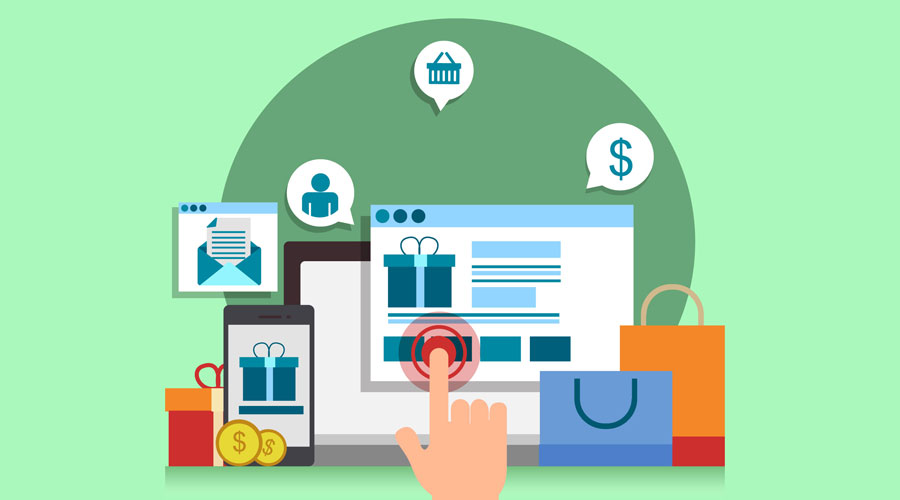Table of Contents
Introduction to E-commerce Marketplaces
In today’s digital age, the e-commerce landscape has witnessed a remarkable transformation. Traditional brick-and-mortar stores are gradually being replaced by online marketplaces that offer a broader range of products, convenience, and seamless shopping experiences. This introduction delves deeper into the world of e-commerce marketplaces, shedding light on their significance, evolution, and how they have revolutionized the way we shop and conduct business online.
The Significance of E-commerce Marketplaces
E-commerce marketplaces, also known as online marketplaces, have emerged as the digital epicenters of modern commerce. These platforms serve as virtual meeting points, connecting buyers and sellers from all corners of the globe. They are the ultimate shopping destinations, offering a vast and diverse catalog of products that cater to virtually every consumer need and desire. The significance of e-commerce marketplaces lies in several key aspects:
- Consumer Convenience: Marketplaces provide consumers with the convenience of shopping for a wide range of products from various sellers within a single platform. No longer do shoppers need to visit multiple websites or stores to fulfill their shopping lists; everything they need is conveniently available in one place.
- Global Reach: E-commerce marketplaces have transcended geographical boundaries, enabling businesses to reach a global audience. Sellers can access markets that were once inaccessible, and buyers can explore a world of products and brands without leaving their homes.
- Diverse Product Catalog: These platforms boast diverse and extensive product catalogs, spanning from fashion and electronics to handmade crafts and vintage items. Consumers can discover niche products and exclusive offerings that might not be available in traditional retail settings.
- Consumer Trust: Established e-commerce marketplaces often enjoy a high level of consumer trust and credibility. Shoppers have confidence in the safety and reliability of their transactions, thanks to the reputation and robust infrastructure of these platforms.
- Economic Opportunities: For entrepreneurs and small businesses, e-commerce marketplaces offer an accessible entry point into the world of online sales. Startups and independent sellers can leverage these platforms to reach a broad audience and build their businesses.
- Competition and Innovation: The competitive nature of e-commerce marketplaces encourages sellers to continuously improve their products and services. This competition drives innovation, ensuring that consumers benefit from the latest trends and advancements.
- Scalability: As businesses grow, marketplaces provide a scalable solution that eliminates the need for significant infrastructure investments. Sellers can expand their operations without the hassle of setting up and maintaining their independent e-commerce websites.
The Evolution of E-commerce Marketplaces
E-commerce marketplaces have come a long way since their inception. Their evolution mirrors the rapid advancements in technology, changes in consumer behavior, and shifts in the global economy. The journey of e-commerce marketplaces can be divided into several key phases:
- Emergence of Online Classifieds: The concept of online classifieds, where individuals could list and sell items, laid the foundation for e-commerce marketplaces. Websites like Craigslist and eBay pioneered this model.
- The Rise of Online Marketplaces: With the advent of Amazon and eBay, e-commerce marketplaces started gaining traction in the late 1990s. These platforms allowed businesses to sell products directly to consumers, expanding beyond individual listings.
- Specialized Niche Marketplaces: Over time, specialized niche marketplaces emerged, catering to specific industries, such as fashion (e.g., ASOS), handmade crafts (e.g., Etsy), and electronics (e.g., Newegg).
- The Gig Economy and Service Marketplaces: E-commerce marketplaces evolved to include services, giving rise to the gig economy. Platforms like Uber, Airbnb, and Upwork provide a platform for individuals to offer services to a global clientele.
- Mobile Commerce: The proliferation of smartphones and mobile apps has further transformed e-commerce. Marketplaces like Alibaba and Taobao in China have capitalized on mobile commerce, making it a dominant force in the industry.
- Blockchain and Cryptocurrencies: Some marketplaces are exploring blockchain technology and cryptocurrencies to enhance security and transparency in online transactions.
- AI and Personalization: Marketplaces are increasingly utilizing artificial intelligence to personalize the shopping experience. AI-driven recommendations and chatbots have become common features.
Key Features of E-commerce Marketplaces
In addition to the essential elements mentioned earlier, successful e-commerce marketplaces often incorporate specific features that enhance the user experience and drive business growth. These key features are crucial to consider when building or improving your e-commerce marketplace:
- Multi-Vendor Support: E-commerce marketplaces should allow multiple vendors or sellers to register and manage their own online storefronts. Each seller should have access to a seller dashboard for inventory management, order processing, and customer communication.
- Commission System: Implement a commission structure that allows you to earn a percentage of each sale made on your platform. This provides a revenue stream while incentivizing sellers to list quality products and drive sales.
- Advanced Search and Filters: Offer advanced search options and filters that help customers find products quickly. These filters can include sorting by price, brand, size, color, and more. Predictive search functionality can also enhance the shopping experience.
- Wishlist and Compare: Allow users to create wishlists and compare products side by side. This feature can improve the buying decision process and encourage repeat visits.
- Ratings and Reviews: Enable customers to rate and review products and sellers. These reviews build trust and transparency within your marketplace, helping buyers make informed choices.
- Order Tracking: Implement an order tracking system that allows customers to monitor the progress of their orders from purchase to delivery. Real-time updates and notifications can improve customer satisfaction.
- Secure Payment Escrow: Use a payment escrow system to hold customer payments until the order is delivered or the return period expires. This builds trust and ensures a secure transaction process.
- Vendor Verification and Quality Control: Establish a vetting process for new sellers to ensure product quality and reliability. Consider implementing quality control measures to maintain product standards.
- Customizable Storefronts: Let vendors customize their storefronts with branding, banners, and unique designs to stand out in the marketplace.
- Cross-Selling and Upselling: Implement product recommendations to encourage cross-selling (suggesting related products) and upselling (suggesting higher-value alternatives) to increase the average order value.
- Membership and Subscription Plans: Offer vendors different membership or subscription plans with varying benefits, such as lower commissions, premium placement, or marketing support.
- Multi-Language and Multi-Currency Support: If you’re targeting an international audience, provide language and currency options to make the shopping experience more accessible and comfortable for users worldwide.
- Analytics and Reporting: Equip sellers with analytics tools to track their sales, traffic, and customer behavior. Additionally, provide marketplace administrators with comprehensive analytics to monitor the platform’s performance.
- Customer Loyalty Programs: Create loyalty programs or rewards systems to encourage repeat purchases and brand loyalty. Offer discounts, cashback, or exclusive deals to loyal customers.
- Social Media Integration: Enable social sharing and integration, allowing users to share their favorite products and reviews on social media platforms, which can drive additional traffic to your marketplace.
- Live Chat and Support: Offer real-time customer support through live chat, helping users with product inquiries, order issues, and general assistance.
- Advanced Security Measures: Invest in robust security measures to protect user data and financial information. SSL certificates, data encryption, and secure payment gateways are crucial for a trustworthy marketplace.
- User Generated Content: Encourage user-generated content like photos and videos showcasing products they’ve purchased. This content can serve as social proof and boost sales.
Choosing the Right E-commerce Marketplace Solution
Selecting the right e-commerce marketplace solution is a critical decision that can significantly impact the success of your online business. The marketplace software you choose will determine the features, scalability, and customizability of your platform. Here are some additional considerations when selecting the perfect e-commerce marketplace solution:
- Scalability and Customization: One of the first things to consider is how well the software can scale as your business grows. The platform should offer room for expansion, allowing you to add more products, sellers, and features. Additionally, customization options are essential to tailor the platform to your specific needs. Look for software that allows you to modify the design, add new functionalities, and integrate third-party tools seamlessly.
- Cost and Budget: The cost of e-commerce marketplace software can vary significantly. Some solutions are open-source and free, while others are subscription-based or require a one-time purchase. You must consider your budget and determine whether the software’s cost aligns with your financial resources. Remember to factor in ongoing expenses, such as hosting, maintenance, and support.
- User-Friendliness: Not all e-commerce marketplace solutions are created equal when it comes to ease of use. Your chosen software should be user-friendly for both administrators and sellers. A complicated backend can lead to confusion and inefficiencies. Consider platforms that offer a user-friendly dashboard for sellers and an intuitive admin interface for you to manage the marketplace effortlessly.
- Security: Security is paramount in e-commerce, as it involves financial transactions and personal data. Ensure that the marketplace software you choose provides robust security features. Look for options with SSL certification, data encryption, and regular security updates. The software should also have measures in place to protect against fraud and data breaches.
- Support and Updates: Regular updates and ongoing support are essential for the long-term success of your marketplace. Opt for software that has an active development team behind it. This ensures that the platform will receive necessary updates and improvements. Additionally, check if the software provider offers customer support, including technical assistance and troubleshooting.
- Third-Party Integrations: To enhance the functionality of your marketplace, consider software that allows easy integration with third-party apps and services. These integrations can expand your marketplace’s capabilities, such as connecting with popular payment gateways, marketing tools, and analytics platforms.
- Payment Gateway Compatibility: The ability to process payments seamlessly is vital for any e-commerce platform. Ensure that the marketplace solution you choose supports a variety of payment gateways to cater to different customer preferences. Offering multiple payment options can boost customer satisfaction and conversion rates.
- Marketplace Community: Some e-commerce marketplace solutions have active user communities and forums where you can seek help, advice, and solutions to common issues. Being part of a supportive community can be incredibly valuable when you face challenges or need guidance in managing your platform.
- Performance and Speed: A slow-loading website can drive away potential customers. Make sure the software you choose is optimized for performance, ensuring that your marketplace loads quickly, even during peak traffic. Fast loading times not only improve the user experience but also contribute to better SEO rankings.
- Analytics and Reporting: To make informed decisions and track the performance of your marketplace, you’ll need access to analytics and reporting tools. Look for software that provides detailed insights into sales, customer behavior, and product performance. This data can guide your marketing and business strategies.
Building vs. Using a Prebuilt Solution
When considering e-commerce marketplace website solutions, you must decide whether to build a custom platform from scratch or use a prebuilt solution. Each approach has its advantages and disadvantages, and the choice depends on your specific business needs and goals. Let’s explore the pros and cons of building versus using a prebuilt solution:
Building a Custom Marketplace:
Advantages:
- Tailored to Your Needs: Building a custom solution allows you to create a platform that is precisely tailored to your unique requirements and business model. You have full control over the design, features, and functionality.
- Competitive Advantage: A custom-built marketplace can set you apart from competitors by offering distinctive features and a more seamless user experience that aligns perfectly with your brand.
- Scalability: You have the flexibility to scale your platform as your business grows, making it easier to adapt to changing market demands and user preferences.
- Ownership and Control: You retain full ownership and control over the code and data, which is crucial for data security and long-term sustainability.
Disadvantages:
- Time and Cost: Custom development is often time-consuming and expensive. It requires a skilled development team, which can be costly, and the development process may take several months or even years.
- Complexity: Building a custom marketplace is complex and requires expertise in various areas, including development, security, and infrastructure.
- Maintenance and Updates: You are responsible for ongoing maintenance, updates, and bug fixes, which can be a continuous resource and cost commitment.
Using a Prebuilt Solution:
Advantages:
- Quick Launch: Prebuilt solutions are ready to use, enabling you to launch your marketplace quickly. This can be advantageous if you want to enter the market rapidly.
- Lower Initial Cost: Prebuilt solutions typically have lower initial costs compared to custom development since you don’t need to hire a development team.
- Community and Support: Many prebuilt platforms have active user communities and support resources, making it easier to find solutions to common issues.
- Regular Updates: Prebuilt solutions often come with regular updates and security patches, reducing the burden of ongoing maintenance.
Disadvantages:
- Limited Customization: Prebuilt solutions have limitations when it comes to customization. You may need to adapt your business model to fit the platform’s features.
- Lack of Uniqueness: Since prebuilt solutions are used by multiple businesses, your marketplace may lack the uniqueness and differentiation that a custom-built platform can offer.
- Scalability Challenges: Prebuilt solutions may not be as flexible or scalable as custom platforms, limiting your ability to grow and adapt to changing needs.
- Ownership and Control: You might have limited control over the code and data, which can be a concern for data privacy and security.
E-commerce Marketplace Success Stories
Now that we’ve covered the essential elements of e-commerce marketplace website solutions, let’s delve into some inspiring success stories of online marketplaces that have redefined the way we shop and have made a significant impact in the e-commerce industry. These stories demonstrate that with the right approach, dedication, and innovative thinking, you can achieve remarkable success in the world of online marketplaces.
-
Amazon: The Pinnacle of E-commerce Marketplaces
Amazon is undoubtedly one of the most iconic and successful e-commerce marketplaces in the world. Founded by Jeff Bezos in 1994 as an online bookstore, Amazon has since transformed into a global marketplace that offers a vast array of products, including electronics, clothing, household items, and more. What set Amazon apart from the beginning were its customer-centric policies, such as convenient shipping options, easy returns, and a focus on continuously improving the shopping experience. The introduction of Amazon Prime further revolutionized e-commerce by offering fast and free shipping to subscribers. Today, Amazon sets the benchmark for e-commerce marketplaces worldwide and serves as an inspiration for those looking to enter the industry.
-
eBay: Pioneering Online Auctions
eBay, founded in 1995 by Pierre Omidyar, pioneered the concept of online auctions and created a dynamic e-commerce platform that allows individuals to buy and sell products, both new and used. The ability for anyone to become a seller on eBay was a game-changer, and it helped build a sense of trust among users. eBay’s success story lies in its dedication to creating a community-driven marketplace where buyers and sellers can engage in a wide range of transactions. Over the years, eBay has diversified its offerings, including fixed-price listings and a “Buy It Now” option, catering to various types of buyers. It’s a testament to the flexibility and adaptability that can lead to long-term marketplace success.
-
Alibaba: Connecting Global Buyers and Sellers
Alibaba, founded by Jack Ma in 1999, has redefined the concept of global trade. The platform’s primary mission is to connect buyers and sellers, particularly those in China, with international markets. Alibaba’s success lies in its commitment to providing a vast range of products, often at competitive prices, to buyers around the world. It has also introduced innovative features like Alibaba Trade Assurance, which provides a level of trust and security for international transactions. By connecting businesses worldwide, Alibaba has demonstrated how e-commerce marketplaces can break down geographical barriers and foster global trade opportunities.
-
Etsy: The Artisan’s Marketplace
Etsy, founded in 2005, has created a unique niche in the e-commerce marketplace industry by focusing on handmade and artisanal products. The platform’s success is attributed to its strong community of sellers and buyers who appreciate the authenticity and individuality of the products listed on Etsy. The marketplace prioritizes supporting small businesses and artisans, providing them with a platform to reach a global audience. Etsy’s success underscores the value of catering to niche markets and fostering a sense of community among its users.
-
Shopify: Empowering Online Entrepreneurs
Shopify, founded in 2006 by Tobias Lütke, Daniel Weinand, and Scott Lake, is a success story that revolves around empowering individuals and small businesses to create their own online stores. Shopify’s e-commerce solution simplifies the process of setting up an online marketplace, providing a range of customizable templates, tools, and resources. Its success can be attributed to its focus on user-friendliness and a commitment to helping entrepreneurs succeed in the digital realm. Shopify’s impact has been particularly profound during the COVID-19 pandemic, as it facilitated the transition of countless businesses to the online space.
-
Poshmark: Reshaping the Fashion Marketplace
Poshmark, founded by Manish Chandra in 2011, has reimagined the fashion resale marketplace. The platform focuses on social commerce, allowing users to buy and sell pre-owned fashion items while fostering a sense of community. Poshmark’s success story highlights the importance of combining e-commerce with social elements, such as sharing, following, and engaging with other users. The marketplace’s unique approach has resonated with fashion enthusiasts, leading to its significant growth.
Future Trends in E-commerce Marketplace Solutions
The e-commerce landscape is a dynamic and ever-evolving realm. As we delve into the intricacies of e-commerce marketplace website solutions, it’s essential to stay ahead of the curve and anticipate future trends that will shape the industry. This article will not only guide you through the fundamental elements of e-commerce marketplaces but also shed light on the exciting trends that are set to redefine the way we shop online.
I. Essential Elements of E-commerce Marketplace Website Solutions (Recap)
Before we explore future trends, let’s quickly recap the essential elements of e-commerce marketplace website solutions:
- User-Friendly Interface
- Seller Dashboard
- Secure Payment Gateways
- Product Listings
- Review and Rating System
- Search Engine Optimization (SEO)
- Mobile Responsiveness
- Customer Support
- Inventory Management
- Shipping and Logistics
These elements lay the foundation for any successful e-commerce marketplace, and staying updated with the latest advancements in these areas is crucial to compete effectively.
II. Future Trends in E-commerce Marketplace Solutions
- AI-Powered Personalization: Artificial intelligence and machine learning will play a pivotal role in personalizing the shopping experience. E-commerce marketplaces will utilize AI to analyze user behavior and preferences, enabling tailored product recommendations, personalized marketing, and dynamic pricing strategies.
- Voice Commerce: The rise of voice-activated devices and virtual assistants like Amazon’s Alexa and Google Assistant will lead to a surge in voice commerce. E-commerce marketplaces will need to optimize their platforms for voice search and provide a seamless shopping experience through voice commands.
- Augmented Reality (AR) and Virtual Reality (VR): AR and VR technologies are set to revolutionize how customers interact with products online. Shoppers will be able to visualize products in their real-world environments using AR, and VR will offer immersive virtual shopping experiences. These technologies will be particularly relevant in industries like fashion, home decor, and automotive.
- Sustainability and Ethical Shopping: As consumers become more environmentally and socially conscious, e-commerce marketplaces will need to highlight eco-friendly and ethically sourced products. Integrating sustainability into product listings and marketing will be a key trend.
- Blockchain for Trust and Transparency: Blockchain technology can enhance trust and transparency in e-commerce transactions. It can be used for supply chain tracking, counterfeit prevention, and secure payment processing, reducing fraud and building confidence among customers.
- Cryptocurrency Payments: Cryptocurrencies are gaining acceptance as a legitimate payment method. E-commerce marketplaces may start accepting cryptocurrencies as a form of payment, offering a secure and borderless alternative to traditional payment methods.
- Multi-Channel Selling: E-commerce marketplaces will embrace multi-channel selling strategies, allowing sellers to expand their reach across various platforms, including social media, online marketplaces, and their own websites. This will enable sellers to tap into a wider customer base.
- Subscription Models: Subscription-based e-commerce marketplaces will become more prevalent, offering customers a regular supply of products or services. This approach can foster customer loyalty and provide a predictable revenue stream.
- Live Commerce: Live streaming and real-time shopping experiences will gain traction. Sellers can interact with customers in real-time, showcase products, answer questions, and close sales during live broadcasts. Live commerce combines entertainment with shopping, creating a unique engagement opportunity.
- Omnichannel Customer Support: Providing a seamless customer support experience across various channels, including chat, email, phone, and social media, will become the norm. Integration of AI chatbots and virtual assistants will enhance efficiency.
- Green Logistics: E-commerce marketplaces will prioritize environmentally friendly shipping and logistics options. From electric delivery vehicles to carbon-neutral shipping, sustainability will be integrated into the entire supply chain.















